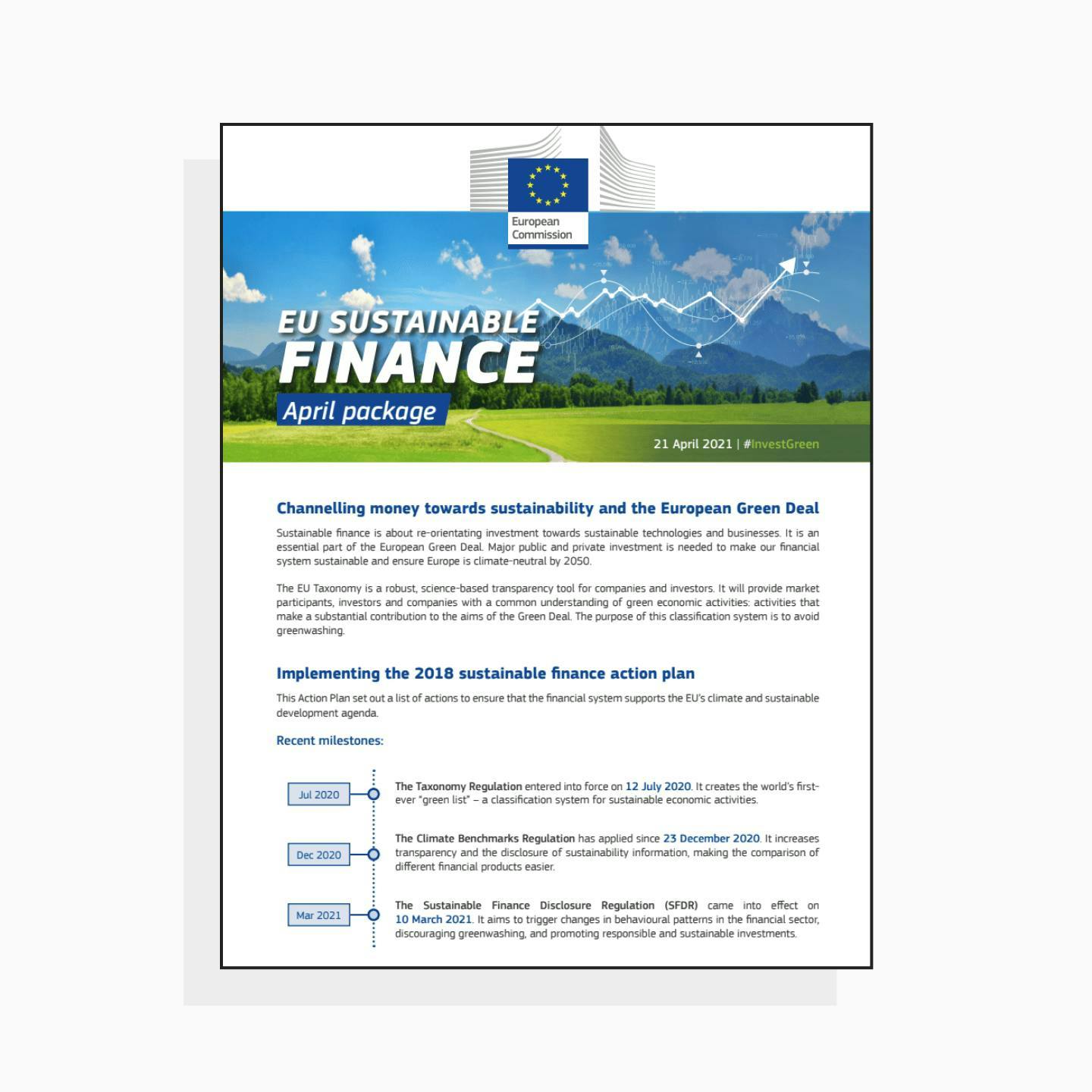

The Corporate Sustainability Reporting Directive (CSRD) makes it mandatory for all ‘large companies’ in the EU to submit sustainability reporting.
In this article we'll cover everything you need to know about the Corporate Sustainability Reporting Directive:
- What is the Corporate Sustainability Reporting Directive?
- Who does the CSRD apply to?
- When does the CSRD come into effect?
- What will reporting include?
- How can companies prepare?

What is the Corporate Sustainability Reporting Directive?
The Corporate Sustainability Reporting Directive (CSRD) makes it mandatory for all ‘large companies’ in the EU to submit sustainability reporting.
It came about after a comprehensive review of the effectiveness of the EU Non Financial Reporting Directive (NFRD) in 2020. A few key issues were determined:
- The NFRD was not mandatory
- The European Commission issued ‘guidance’ on how to report under the Directive, but it wasn’t required to follow that guidance, and so there was no standardised way for companies to report sustainability information.
- There was no requirement for third party, independent auditing to check and verify the reporting submitted.
The CSRD was developed to address these issues and as part of the wider EU Sustainable Finance package, which aims to increase the flow of money towards sustainable activities across the EU. It is also the cornerstone of the EU Green Deal, which aims to make the EU the first carbon neutral area in the world by 2030.

The European Parliament officially voted to adopt the CSRD on 10 November 2022 with a huge majority of 525 votes in favour of the regulation.
The regulation is aiming to increase business climate action and the transparency and accuracy of environmental reporting by businesses (thus also reducing corporate greenwashing) – achieved through mandatory reporting against standardised requirements and third-party auditing.
Subscribe for the latest insights into driving climate positivity
Who does the Corporate Sustainability Reporting Directive apply to?
The Corporate Sustainability Reporting Directive applies to all large companies operating in the EU, meaning those companies which meet the following criteria:
- Organisations listed in an EU-regulated market with 500+ employees
- Large EU undertakings: listed or non-listed companies meeting 2 or more of the following criteria: € 25M+ total assets, € 50M+ net turnover, and/or 250+ employees
- SMEs listed on EU-regulated markets
In total, this represents around 50,000 companies or around 75% of the total turnover of all EU companies.
Plus, supplier companies outside of the scope of the legislation will face pressure to report on sustainability from those companies who are now mandated to report. For instance, if a logistics company acts as a logistics supplier for a large company, they will be asked by that company to provide details on the environmental impact of their services.
So, it’s a big deal in terms of the companies impacted.
What will reporting need to include?
Reporting under the CSRD will need to meet the EU Sustainability Reporting Standards (ESRS), developed by the European Financial Reporting Advisory Group. These standards span all areas of ESG (Environmental, Social, Governance). Some of the important factors to be aware of are:
- Sustainability reporting is submitted alongside standard financial reporting – it will no longer be seen as a separate, standalone report.
- ‘Double materiality’ is included (for the first time) – meaning that companies must report on how their business impacts people and the planet, as well as how sustainability and climate impacts their business.
- Scope 3 emissions are included in emissions reporting, meaning that there will be a need for collaboration and extensive data gathering across the entire value chain and with all suppliers. If scope 3 emissions are deemed immaterial, then an explanation must be given as to why.
- Reports must be submitted digitally.
- Reports must be audited by an independent, third-party to ensure sustainability reporting by companies is reliable and comparable
We’ll update this post with the details once the Standards are adopted, so make sure you bookmark it safely – and you can sign up to our monthly newsletter to be notified too.
When does the CSRD come into effect?
The regulation will come into effect across 4 phases – meaning it will be fully in place by 2029.
Phase 1: Companies already subject to the EU Non Financial Reporting Directive must begin reporting in 2025 on their 2024 financial year
Phase 2: Large companies not currently subject to the EU Non Financial Reporting Directive must begin reporting in 2026 on their 2025 financial year
Phase 3: Listed SMEs must begin reporting in 2027 on their 2026 financial year
Phase 4: International and non-EU companies must begin reporting in 2029 on their 2028 financial year
 Timeline of EU CSRD rollout
Timeline of EU CSRD rolloutHow can companies prepare for the Corporate Sustainability Reporting Directive coming into effect?
If your company is included in those that will need to comply with the Corporate Sustainability Reporting Directive, we’d recommend starting to get everything in order sooner rather than later.
And, we’re likely to see more and more corporate sustainability reporting legislation come into force globally over the next few years for all kinds of businesses – so even if your company won’t be required to report on environmental impact by the CSRD, it’s still a good idea to get ahead of the game. Plus, beyond the legislation, there’s a very strong business case for working on sustainability anyway – from risk management to customer loyalty to employee satisfaction and more.
There are plenty of actions to get started with to put you in good stead for the changes:
- Calculate your existing carbon emissions to understand your starting point and identify areas for improvement.
- Set rigorous targets and KPIs to reduce emissions as much as possible, always using a respected framework such as Science Based Targets.
- Buy high-quality offsets to compensate for emissions you’re unable to reduce (or that will need long-term work to reduce).
- Identify climate risks to your business, and put mitigation measures in place – climate should definitely be part of your risk management process.
- Explore climate opportunities in your industry – how could your business respond to climate change beyond your own carbon footprint? For instance, in the payments industry that may be exploring how to offer consumers and/or businesses a ‘green’ payments alternative.
As a first step, developing an impactful sustainability strategy which lays out how you will approach sustainability – including all of the actions above – how it aligns with your overall goals and vision, and how different roles within the business will contribute to this, will ensure that there’s strategic alignment and buy-in on sustainability.
Download Lune's free sustainability checklist to get started.
Subscribe for the latest insights into driving climate positivity
Readers also liked
Readers also liked

Subscribe for emissions intelligence insights
Get the latest updates in the world of carbon tracking, accounting, reporting, and offsetting direct to your inbox.


